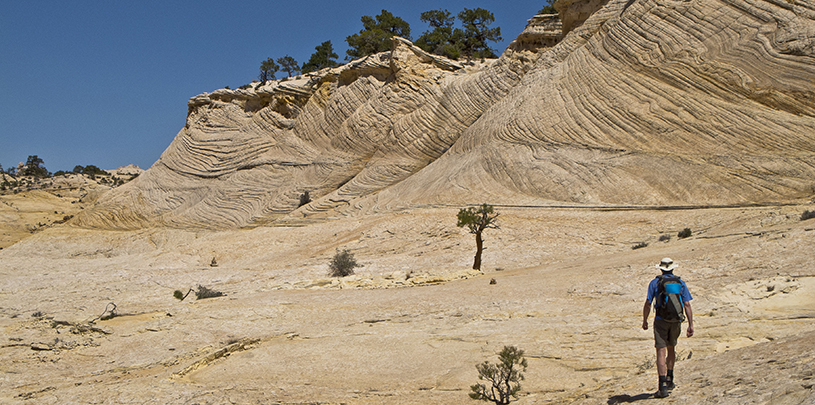
 by Mary O'Brien, Utah Forests Manager
by Mary O'Brien, Utah Forests Manager
On September 18, 2016, Grand Staircase-Escalante National Monument became 20 years old—no longer a teenager. But, like so many teenagers-turning-20, it’s still a work in progress.
When, on September, 18, 1996, President Bill Clinton proclaimed the first national monument to be placed under Bureau of Land Management (BLM) administration, he accomplished something immediately: the Kaiparowits Plateau, a treasure house of Late Cretaceous dinosaur remains and swamp plant fossils, would not be torn apart for coal. At least these public lands would not be put to work further heating up our Earth.
Indeed, in the past 20 years, paleontologists and volunteers have discovered 21 new dinosaur species in the monument. Volunteers, organized through Grand Staircase Escalante Partners, have faithfully contributed to science research, restoration, and protection in the monument. In addition, the Escalante River Watershed Partnership has attracted millions of dollars, youth crews, and volunteers for removal of exotic, aggressive Russian olive from the Escalante River and its tributaries.
But too much of the monument’s 20-year story is one of unfulfilled promises and unnecessary decline. In President Clinton’s proclamation, protection of the biological, archaeological, and paleontological resources was to be a defining feature of the Grand Staircase-Escalante National Monument. A Monument Management Plan signed in 1999 envisioned conservation of the native and natural vegetation, wildlife, water, soil, and archaeological resources. Alas, too much of that vision morphed into BLM business-as-usual.
In 2000, the monument had a staff of 17 scientists dedicated to science, rather than collateral duties (e.g., archaeological clearance for a new water trough). There is now one monument scientist – a paleontologist - able to undertake research, partner with other scientists, and attract and inform citizen scientists and volunteers. The handful of other “-ologists” are primarily assigned to cattle grazing support and planning. After 20 years, the monument still has no grazing plan, though active cattle allotments blanket 96.4 percent of it.

Left: The Gulch, a tributary to the Escalante River in Grand Staircase-Escalante National Monument, heavily grazed by cattle (photo by Bureau of Land Management). Right: Calf Creek, a tributary to the Escalante River in Grand Staircase-Escalante National Monument, not grazed by cattle since 1996 (photo by Ellen Morris-Bishop).
Tens of thousands of acres of the monument’s sagebrush lands have been torn up and seeded to exotic pasture grasses, such as crested wheatgrass. The monument has a greater grazing staff-to-acre ratio than any other BLM unit in the West.
The monument’s budget in 2016 is one-third of what it was just 10 years ago. Recently, scarce BLM dollars went to providing the Kanab visitor center with a glass wall at the information desk that is resistant to bullets and jumps over the counter, along with office panic buttons, and window film that is impact-proof against thrown rocks or sledge hammers.
It doesn’t have to be this way, and must not be this way, particularly in the face of global warming’s promise of ever-more punishing high temperatures and drought, and ever-growing numbers of visitors. As always, there are alternatives. There is a new state BLM Director, Ed Roberson. There will be an alternative (“Alternative C”) in the upcoming Draft Environmental Impact Statement for the Monument’s first-ever grazing plan. Alternative C would provide for better cattle management and a better balance of grazed and cattle-free lands within this remote, arid, stunning landscape.
And so, on the monument’s 20th birthday, there is much to be grateful for, much that is alarming, and much to work toward. In 1996 the ancient and myriad lives in these lands at the southern border of Utah were honored and protected as Grand Staircase-Escalante National Monument. On its 20th birthday, we can and should pay that honor and protection forward.
As 2024 draws to a close, we look back at five maps we created this year that give us hope for 2025.
Read MoreThe new Grand Canyon national monument allows traditional uses like hunting and ranching to continue.
Read MoreYou have the opportunity to comment on how you think some of the most beautiful landscapes in Utah should be managed for the next generation to come.
Read More